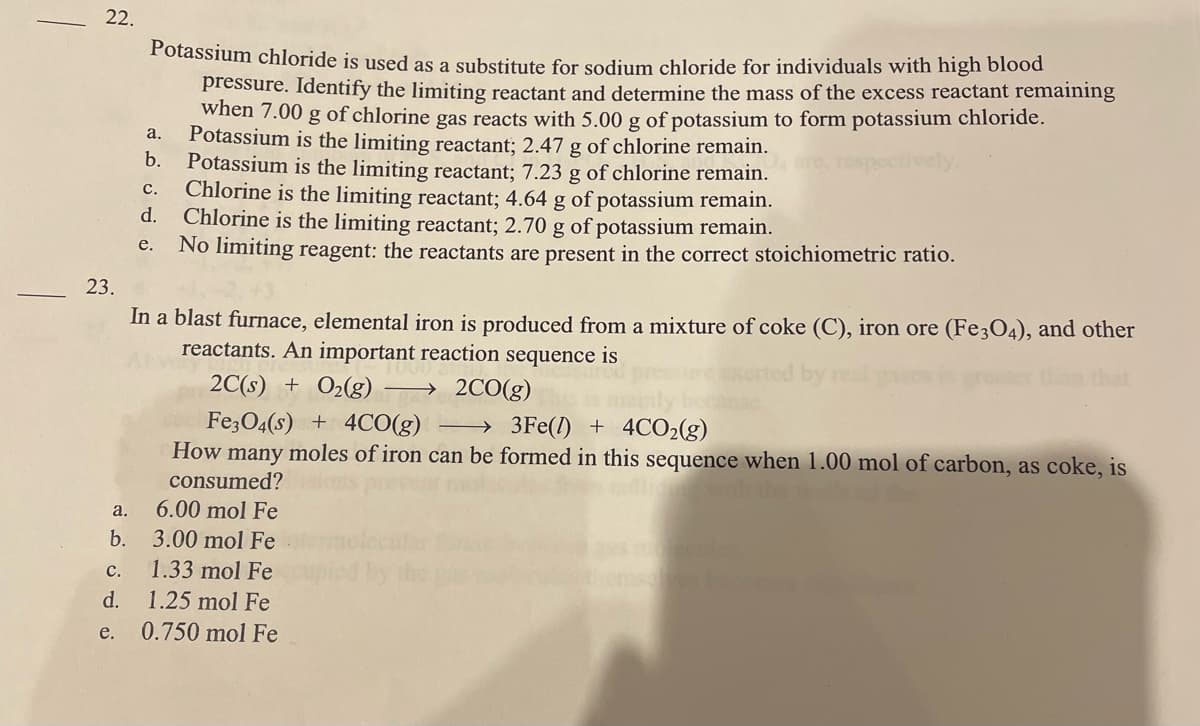Potassium chloride is used as a substitute for sodium chloride for individuals with high blood pressure. Identify the limiting reactant and determine the mass of the excess reactant remaining when 7.00 g of chlorine gas reacts with 5.00 g of potassium to form potassium chloride. Potassium is the limiting reactant; 2.47 g of chlorine remain. b. Potassium is the limiting reactant; 7.23 g of chlorine remain. Chlorine is the limiting reactant; 4.64 g of potassium remain. d. a. с. Chlorine is the limiting reactant; 2.70 g of potassium remain. No limiting reagent: the reactants are present in the correct stoichiometric ratio. e.
Potassium chloride is used as a substitute for sodium chloride for individuals with high blood pressure. Identify the limiting reactant and determine the mass of the excess reactant remaining when 7.00 g of chlorine gas reacts with 5.00 g of potassium to form potassium chloride. Potassium is the limiting reactant; 2.47 g of chlorine remain. b. Potassium is the limiting reactant; 7.23 g of chlorine remain. Chlorine is the limiting reactant; 4.64 g of potassium remain. d. a. с. Chlorine is the limiting reactant; 2.70 g of potassium remain. No limiting reagent: the reactants are present in the correct stoichiometric ratio. e.
Chemistry
10th Edition
ISBN:9781305957404
Author:Steven S. Zumdahl, Susan A. Zumdahl, Donald J. DeCoste
Publisher:Steven S. Zumdahl, Susan A. Zumdahl, Donald J. DeCoste
Chapter3: Stoichiometry
Section: Chapter Questions
Problem 120E: The space shuttle environmental control system handles excess CO2 (which the astronauts breathe out;...
Related questions
Question

Transcribed Image Text:22.
Potassium chloride is used as a substitute for sodium chloride for individuals with high blood
pressure. Identify the limiting reactant and determine the mass of the excess reactant remaining
when 7.00 g of chlorine gas reacts with 5.00 g of potassium to form potassium chloride.
Potassium is the limiting reactant; 2.47 g of chlorine remain.
b.
а.
Potassium is the limiting reactant; 7.23 g of chlorine remain.
Chlorine is the limiting reactant; 4.64 g of potassium remain.
d.
с.
Chlorine is the limiting reactant; 2.70 g of potassium remain.
No limiting reagent: the reactants are present in the correct stoichiometric ratio.
e.
23.
In a blast furnace, elemental iron is produced from a mixture of coke (C), iron ore (Fe3O4), and other
reactants. An important reaction sequence is
2C(s) + O2(g)
→ 2C0(g)
an that
Fe;O4(s) + 4CO(g)
How many moles of iron can be formed in this sequence when 1.00 mol of carbon, as coke, is
consumed?
→ 3Fe(1) + 4CO2(g)
а.
6.00 mol Fe
b.
3.00 mol Fe
les
с.
1.33 mol Fe
d.
1.25 mol Fe
е.
0.750 mol Fe
Expert Solution
This question has been solved!
Explore an expertly crafted, step-by-step solution for a thorough understanding of key concepts.
This is a popular solution!
Trending now
This is a popular solution!
Step by step
Solved in 3 steps

Knowledge Booster
Learn more about
Need a deep-dive on the concept behind this application? Look no further. Learn more about this topic, chemistry and related others by exploring similar questions and additional content below.Recommended textbooks for you

Chemistry
Chemistry
ISBN:
9781305957404
Author:
Steven S. Zumdahl, Susan A. Zumdahl, Donald J. DeCoste
Publisher:
Cengage Learning


Chemistry: An Atoms First Approach
Chemistry
ISBN:
9781305079243
Author:
Steven S. Zumdahl, Susan A. Zumdahl
Publisher:
Cengage Learning

Chemistry
Chemistry
ISBN:
9781305957404
Author:
Steven S. Zumdahl, Susan A. Zumdahl, Donald J. DeCoste
Publisher:
Cengage Learning


Chemistry: An Atoms First Approach
Chemistry
ISBN:
9781305079243
Author:
Steven S. Zumdahl, Susan A. Zumdahl
Publisher:
Cengage Learning

Introductory Chemistry: A Foundation
Chemistry
ISBN:
9781337399425
Author:
Steven S. Zumdahl, Donald J. DeCoste
Publisher:
Cengage Learning

Chemistry & Chemical Reactivity
Chemistry
ISBN:
9781337399074
Author:
John C. Kotz, Paul M. Treichel, John Townsend, David Treichel
Publisher:
Cengage Learning

Chemistry & Chemical Reactivity
Chemistry
ISBN:
9781133949640
Author:
John C. Kotz, Paul M. Treichel, John Townsend, David Treichel
Publisher:
Cengage Learning